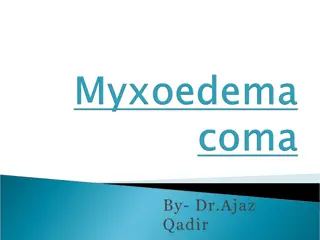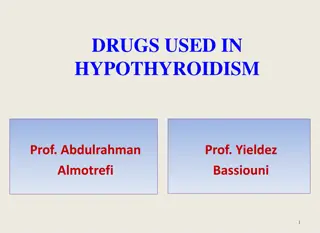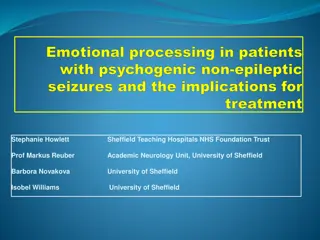Understanding Seizures and Coma: A Comprehensive Overview
This informational content delves into various aspects of seizures and comas, covering topics such as the prevalence of seizures, classification of epilepsy, EEG in epilepsy, seizure history, and different types of seizures like simple partial and complex partial seizures. It provides insights into the characteristics, features, and classifications of seizures and epilepsy, aiding in a better understanding of these neurological conditions.
Download Presentation

Please find below an Image/Link to download the presentation.
The content on the website is provided AS IS for your information and personal use only. It may not be sold, licensed, or shared on other websites without obtaining consent from the author. Download presentation by click this link. If you encounter any issues during the download, it is possible that the publisher has removed the file from their server.
E N D
Presentation Transcript
Seizures and Coma Stephen Deputy, MD, FAAP LSU School of Medicine Children s Hospital, New Orleans, LA John K. Willis, MD
Seizures Lifetime Prevalence Single seizure: 9% * The definition of epilepsy is that of a chronic condition characterized by the occurrence of recurrent, unprovoked seizures Recurrent seizure: 0.5%*
International Classification of Seizures Partial: local onset - Simple: no LOC - Complex: LOC - Secondarily generalized Generalized: bilateral onset
Classification of Epilepsies Localization related - Primary - Secondary Generalized - Primary - Secondary
Classification of Epilepsies Focal Focal Seizures Focal EEG changes Normal EEG up to 60% Narrow Spectrum AED Generalized Generalized Seizures EEG Abnormal Always Generalized Discharges Broad Spectrum AED Rolandic Epilepsy Childhood Absence Juvenile Myoclonic Epilepsies Idiopathic Normal Development Normal Exam Normal EEG Background Normal Neuroimaging Family History Channelopathy Easy to Treat Symptomatic Abnormal +/- Exam, Development, EEG Background, Neuroimaging Difficult to Treat Lesional Epilepsies Infantile Spasms Lennox-Gastaut Syndrome
EEG in Epilepsy Usually only confirmatory Treat patient, not EEG Characteristic EEGs: - Absence - Lennox-Gastaut - Infantile spasms - Rolandic seizures
Seizure History Aura, onset Eye movements Limb movements Duration Consciousness: - To voice, pain - Injury - Incontinence - Amnesia
Simple Partial Seizure Features: Focal motor seizure / Focal sensory seizure Consciousness intact Signs/symptoms variable Motor Somatosensory Autonomic Psychic May have focal EEG abnormality
Partial Complex Seizures Psychomotor, temporal lobe Limbic origin: frontal or temporal Perceptual/emotional aura; Carbamazepine to start Ictal starring Automatisms Postictal confusion
Benign Rolandic seizures BERS School age, normal child Partial: face, arm Generalized: tonic-clonic Sleeping >waking EEG: mid-temporal/central spikes Outgrown in adolescence Rx: limit side effects Carbamazepine, Benzodiazepines qhs
Classification of Epilepsies Focal Focal Seizures Focal EEG changes Normal EEG up to 60% Generalized Generalized Seizures EEG Abnormal Always Generalized Discharges Rolandic Epilepsy Childhood Absence Juvenile Myoclonic Epilepsies Idiopathic Normal Development Normal Exam Normal EEG Background Normal Neuroimaging Family History Channelopathy Easy to Treat Symptomatic Abnormal +/- Exam, Development, EEG Background, Neuroimaging Difficult to Treat Lesional Epilepsies Infantile Spasms Lennox-Gastaut Syndrome
Absence Seizures Hyperventilation for Dx Often clinical: daydreams Automatisms Brief, frequent No postictal state Normal child: 4-10 y.o. May resolve in adolescence Later epilepsy: 30% Rx: Ethosuximide, Lamotrigine, valproic acid
JME Juvenile myoclonic epilepsy of Janz Idiopathic/genetic: normal child First convulsion after sleep loss/alcohol Antecedent early-a.m. myoclonus: incoordination, jerking 90% relapse off meds
JME Normal exam/image EEG: Generalized spike and wave: 3-6 hertz Prior absence: 1/3 Photosensitive: 1/3 Valproic acid: first choice (?) - Lamotrigine - Barbiturates - Ethosuximide - Benzodiazepines - Felbamate - Topiramate
Classification of Epilepsies Focal Focal Seizures Focal EEG changes Normal EEG up to 60% Narrow Spectrum AED Generalized Generalized Seizures EEG Abnormal Always Generalized Discharges Broad Spectrum AED Rolandic Epilepsy Childhood Absence Juvenile Myoclonic Epilepsies Idiopathic Normal Development Normal Exam Normal EEG Background Normal Neuroimaging Family History Channelopathy Easy to Treat Symptomatic Abnormal +/- Exam, Development, EEG Background, Neuroimaging Difficult to Treat Lesional Epilepsies Infantile Spasms Lennox-Gastaut Syndrome
Infantile Spasms Flexor/extensor spasms Hypsarrhythmic EEG Mental retardation: 90% Symptomatic versus idiopathic: Treatment:R/O tuberous sclerosis - ACTH - Steroids - Valproate - Vigabatrin
Lennox-Gastaut Syndrome Minor motor seizures - Akinetic - Myoclonic - Absence - Other Diverse etiologies Mental retardation Difficult control: try Valproate, Lamotragine, Topiramate
Classification of Epilepsies Focal Focal Seizures Focal EEG changes Normal EEG up to 60% Narrow Spectrum AED Generalized Generalized Seizures EEG Abnormal Always Generalized Discharges Broad Spectrum AED Rolandic Epilepsy Childhood Absence Juvenile Myoclonic Epilepsies Idiopathic Normal Development Normal Exam Normal EEG Background Normal Neuroimaging Family History Channelopathy Easy to Treat Symptomatic Abnormal +/- Exam, Development, EEG Background, Neuroimaging Difficult to Treat Lesional Epilepsies Infantile Spasms Lennox-Gastaut Syndrome
Anticonvulsants Attempt monotherapy Follow levels? Watch cognition: - Barbiturates - Phenytoin - Benzodiazepines - Topiramate - Valpoic - Levetiracetam (Any AED!)
Drug Issues Neuroleptics, antihistamines: seizures (?) Phenytoin/Carbamazepine toxicity seizures Interactions: Valproate: [barbiturates] Enzyme inducers Levels (e.g., barbiturates, carbamazepine, phenytoin) [lamotrigine]
Drug Issues Drugs that Lower Seizure Threshold Anti-Histamines Certain Psychotropic Meds ? Stimulants Drug-Drug Interactions Cytochrome P450 Inducers (Pb, DPH, CBZ, Warfarin OCP s, etc) Macrolide Antibiotics and Carbamazepine
Drug Discontinuation 1-2 years seizure free: 75% without seizures off drug Taper over 6 weeks Recurrence: severe prior seizures underlying disease severe EEG abnormality
Initial Drugs (I) Seizure: partial or generalized EEG: normal or focal spikes Carbamazepine (CBC, Na+) (Trileptal) Barbiturates (Lamotrigine) Phenytoin (CBC, LFT s) (Topiramate) Valproic acid (CBC, LFT s) (Zonisamide) (Keppra)
Initial Drugs (II) Seizure: generalized EEG: generalized spike-wave Ethosuximide Felbamate (CBC, LFT s) Valproic acid Vigabatrin Benzodiazepines Lamotrigine Phenobarbital Topiramate Zonisamide
Status Epilepticus Continual seizures May damage brain A medical emergency Remain calm: - History, PE - BS, Na, Ca, Mg - Drug levels - Supportive care
Status Epilepticus: Drugs Glucose IV Rectal Diastat 0.5 mg/kg Lorazepam 0.05 mg/kg IV (Max 4mg) or Diazepam 0.3 mg/kg IV (Max 10mg) Phenobarbital 20 mg/kg IV over 20 minutes
Status Epilepticus: Drugs Phenytoin 20 mg/kg IV 50 mg/min (Fosphenytoin: up to 150 mg/min) Infusions IV: Midazolon 0.15 mg/kg bolus 1 g/kg/min Pentobarbital 10-15 mg/kg bolus 0.5-1.5 mg/kg/hR EEG: burst-suppression
Neonatal Seizures Fragmentary, multifocal, antonomic (apnea, HR) Usually brief, not life-threatening Etiology not pharmacology : structural, vascular, infectious, metabolic EEG : rhythmic discharges
Febrile Seizures <5% incidence: 20% if familial Age 6 month to 6 years Brief, generalized: simple Long, focal, repeated: complex 30% recurrence after One (Risk Factors for Recurrence: Early Age, Family Hx, Low Fever, Multiple Prior FSz s) R/O meningitis (LP if altered MS, nuchal rigidity, prior antibiotic use, age <12 months)
Febrile Seizures ? Treat if recurrent or prolonged - Phenobarbital maintenance (Concerns about Cognition) - Valproate maintenance (Concerns about hepatotoxicity) - PRN Diazepam (Concerns about tolerability and timing of dose)
Febrile Seizures (II) EEG: not useful CT/MRI: not useful Look for Cause of Illness
Febrile Seizures (III) Later epilepsy: - 1%: no risk factors - 10%: two risk factors Risk factors: Abnormal child Complex Febrile Seizures Family history of epilepsy Multiple Febrile Seizures
Epilepsy: Imaging Ultrasound: poor CT MRI: better than CT PET: glucose metabolism - EEG correlation
Pertussis Disease produces neurologic morbidity and disease Vaccine poorly linked to neurologic morbidity Defer vaccine only after a reaction: controversy (unjustified)
Breath-Holding Spells (I) 5% incidence Familial: ? dominant Anemia/iron deficiency Resolve spontaneously: 5 years old Sequel: neurocardiac syncope (17%)
Breath-Holding Spells (II) Stereotyped sequence: Pain/fright/anger Cry briefly Hold breath Cyanosis or pallor (bradycardia) Loss of consciousness Limp/stiff/jerking Rare lengthy seizure
Breath-Holding Spells (III) If sequence atypical: - R/O seizure: EEG - R/O arrhythmia (long Q-T): EKG Consider iron therapy Horizontal position Anticonvulsants for long seizure Reassurance ( My kid did that. )
Tics Rapid movements: Stereotypic in sleep Brief voluntary suppression Rx: Haloperidol (usually unnecessary)
Masturbation (Infantile Gratification Syndrome) Boys: obvious Girls: rubbing legs together pelvic movements Dx often not welcome
Sleep Disorders Hypnic Jerks Sleep Apnea Parasomnias Night Terrors Sleep Walking/Talking ? polysomnogram
Syncope Brief LOC (< 2 min) No subsequent confusion Rare tonic-clonic movements May convulse if held upright
Syncope (Continued) Precipitants: - Dehydration, fasting - Prolonged standing/arising: adolescents - Noxious stimuli: Ven. Puncture Hair-pulling With exercise, swimming: R/O cardiac EKG appropriate
Pseudoseizures Psychogenic (Conversion Disorder) some may also have epilepsy 1/3 females had sexual abuse Dx: No EEG change during seizure Interrupt or Bring On with Distraction or Suggestion
Clinical Tips Continued crying seizure Continuing activity (feeding, play) seizure Interruption by pain (pinch finger) seizure Parental history (?): video Not post-ictal after generalized shaking: ?? seizure
Coma Coma Substrate Both cerebral hemispheres and/or Brainstem (ARAS)
Basis for Coma Metabolic disease versus Structural disease
Coma Exam I Observe, document Avoid jargon Repeat Think anatomy
Coma Exam II Alertness: Spontaneous, induced Movement: Spontaneous, induced Respirations Reflexes Cranial nerves






















